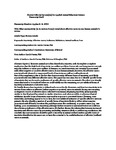What can inactivity (in its various forms) reveal about affective states in non-human animals? A review
| dc.contributor.author | ESTEBAN , ARRIBAS REYES | |
| dc.contributor.author | Meagher, RK | |
| dc.date.accessioned | 2017-12-12T18:10:12Z | |
| dc.date.available | 2017-12-12T18:10:12Z | |
| dc.date.issued | 2015-10 | |
| dc.identifier.issn | 0168-1591 | |
| dc.identifier.issn | 1872-9045 | |
| dc.identifier.uri | http://hdl.handle.net/10026.1/10418 | |
| dc.description.abstract |
Captive/domestic animals are often described as inactive, with the implicit or explicit implication that this high level of inactivity is a welfare problem. Conversely, not being inactive enough may also indicate or cause poor welfare. In humans, too much inactivity can certainly be associated with either negative or positive affective states. In non-human animals, however, the affective states associated with elevated or suppressed levels of inactivity are still not well understood. Part of the complexity is due to the fact that there are many different forms of inactivity, each likely associated with very different affective states. This paper has two aims. One is to identify specific forms of inactivity that can be used as indicators of specific affective states in animals. The other is to identify issues that need to be resolved before we could validly use the remaining, not yet validated forms of inactivity as indicators of affective state. We briefly discuss how inactivity is defined and assessed in the literature, and then how inactivity in its various forms relates to affective (either negative or positive) states in animals, basing our reasoning on linguistic reports of affective states collected from humans displaying inactivity phenotypically similar to that displayed by animals in similar situations, and, when possible, on pharmacological validation. Specific forms of inactivity expressed in response to perceived threats (freezing, tonic immobility, and hiding) appear to be, to date, the best-validated indicators of specific affective states in animals. We also identify a number of specific forms of inactivity likely to reflect either negative (associated with ill-heath, boredom-like, and depression-like conditions), or positive states (e.g. ‘sun-basking’, post-consummatory inactivity), although further research is warranted before we could use those forms as indicators of the affective states. We further discuss the relationship between increased inactivity and affective states by presenting misleading situations likely to yield wrong conclusions. We conclude that more attention should be paid to inactivity in animal welfare studies: specific forms of inactivity identified in this paper are, or have the potential to be, useful indicators of affective (welfare) states in animals. | |
| dc.format.extent | 8-24 | |
| dc.language | en | |
| dc.language.iso | en | |
| dc.publisher | Elsevier BV | |
| dc.subject | Inactivity | |
| dc.subject | Affective states | |
| dc.subject | Indicator | |
| dc.subject | Validation | |
| dc.subject | Animal welfare | |
| dc.subject | Fear | |
| dc.title | What can inactivity (in its various forms) reveal about affective states in non-human animals? A review | |
| dc.type | journal-article | |
| plymouth.author-url | https://www.webofscience.com/api/gateway?GWVersion=2&SrcApp=PARTNER_APP&SrcAuth=LinksAMR&KeyUT=WOS:000364605200002&DestLinkType=FullRecord&DestApp=ALL_WOS&UsrCustomerID=11bb513d99f797142bcfeffcc58ea008 | |
| plymouth.volume | 171 | |
| plymouth.publication-status | Published | |
| plymouth.journal | Applied Animal Behaviour Science | |
| dc.identifier.doi | 10.1016/j.applanim.2015.08.036 | |
| plymouth.organisational-group | /Plymouth | |
| plymouth.organisational-group | /Plymouth/Faculty of Science and Engineering | |
| plymouth.organisational-group | /Plymouth/REF 2021 Researchers by UoA | |
| plymouth.organisational-group | /Plymouth/REF 2021 Researchers by UoA/UoA04 Psychology, Psychiatry and Neuroscience | |
| dcterms.dateAccepted | 2015-08-25 | |
| dc.identifier.eissn | 1872-9045 | |
| dc.rights.embargoperiod | Not known | |
| rioxxterms.versionofrecord | 10.1016/j.applanim.2015.08.036 | |
| rioxxterms.licenseref.uri | http://www.rioxx.net/licenses/all-rights-reserved | |
| rioxxterms.type | Journal Article/Review |


